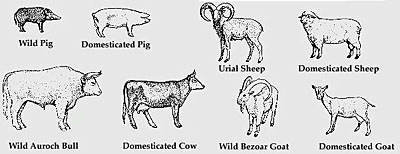Domestication
- page 5 -
Domestication of Animals
The same kinds of genetic transformations occured in the animals domesticated by early farmers and pastoralists. The process of selective breeding of animals was at first unintentional and probably unobserved. For example, large, aggressive, and big-horned bulls were probably too dangerous to keep around and so did not survive to reproduce these characteristics. Thus, over time, early farmers unwittingly altered the genetic make-up of the life forms they most relied on.

The illustrations above show the effects of domestication on some of the livestock species commonly associated with agriculture in western Asia and Europe. Modifications of body size reflecting the uses to which the animal is put, loss of speed and agility, loss or decrease in size of horns or other natural weapons, biological specialization for human needs (e.g., wool production in sheep), are readily apparent. Subtler changes in disposition and intelligence occurred also. Some species of domestic animals could not now survive without human care and protection. Others, however, like the pig, can revert fairly easily to life in the wilds.

